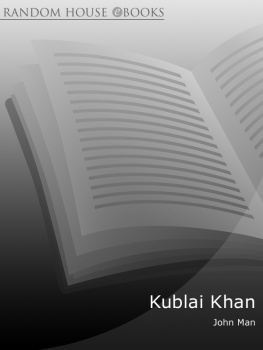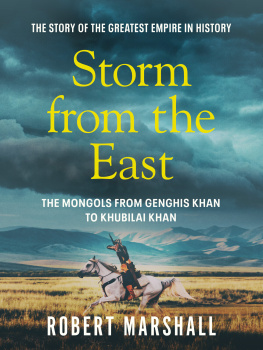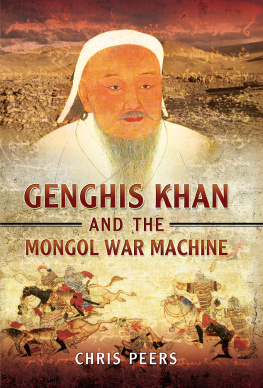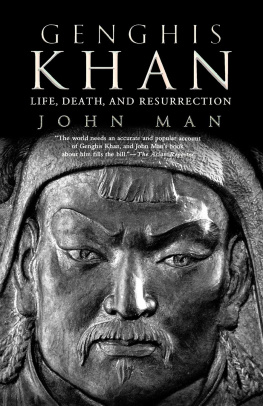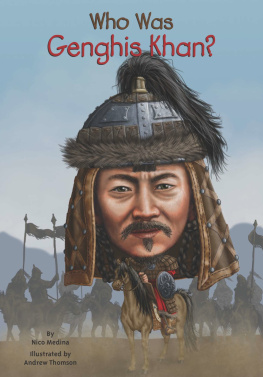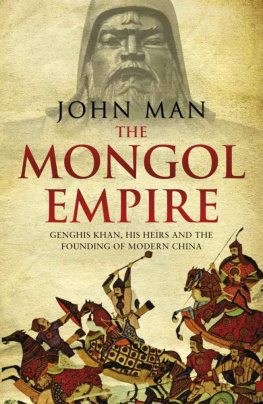About the Book
Kublai Khan, the thirteenth-century Mongolian prince who became warrior emperor of China, was perhaps the most powerful man who ever lived.
Grandson of the great Genghis Khan, he inherited the largest land empire in history and doubled it. Driven to fulfil his grandfathers destiny and ensure Mongol supremacy, Kublais realm would embrace over half of all Asia: a staggering one-fifth of the worlds inhabited land area.
But Kublai Khan was not born to rule. It was his brilliant, scheming mother who placed him in line for the throne. Seizing power when in his forties, he perceived China rather than Mongolia as the key to empire and, after twenty years of war, became the first barbarian to conquer all China. Bringing together vast wealth, military strength and shrewd government, he was to transform his dominion into the prototype of todays superpower.
Drawing on his own travels through Mongolia and China, bestselling historian John Man brings the remarkable world of Kublai Khan to vibrant life.
CONTENTS
KUBLAI KHAN
From Xanadu to Superpower
John Man
MAPS
ILLUSTRATIONS
The page references correspond to the printed edition from which this ebook was created. To find a specific image from the illustrations, please use the search feature of your ebook reader.
Pages with no images credited are all John Man.
FIRST SECTION
Page 1
Tolui and his family, from Jami al-Tawarikh by Rashid al-Din, fourteenth-century, Ms sup. pers. 1113 f. 164v, Bibliothque Nationale, Paris; Karakorum, Dean Conger/Corbis.
Pages 2 and 3
Alamut: Simon Richmond/Lonely Planet Images; Hassan i Sabbah leading the initiations at Alamut, manuscript illumination by the Boucicaut Master (fl.13901430): Bibliothque Nationale, Paris/Bridgeman Art Library; Mongols storming and capturing Baghdad in 1288, from Jami al-Tawarikh by Rashid al-Din, fourteenth-century, Ms sup. pers. 1113 f. 180v-181, Bibliothque Nationale, Paris/Bridgeman Art Library; Mnkhe Khan holds a feast at Karakorum: sixteenth-century illustration of a fourteenth-century Persian history of the Mongols, Werner Forman Archive/Gulistan Library, Teheran.
SECOND SECTION
Pages 2 and 3
Kublai Khans armies lay siege to the Chinese fortress of O-Chou across a pontoon over the Yangtse River: sixteenth-century illustration of a fourteenth-century Persian history of the Mongols, Werner Forman Archive/Gulistan Library, Teheran; A Mongol Siege, detail from a manuscript of Rashid al-Din, Or. MS20 f. 124v, Edinburgh University Library; modern trebuchet, Caerphilly Castle, Wales: general view and detail, John Man; plan of Hangzhou from Henry Yule, The Book of Ser Marco Polo, volume II, 1903.
Pages 4 and 5
Street theatre, Guyuan, Gansu province, 2002, photo John Man; The Student Chang Bidding Farewell to his lover Ying Ying at the Rest Pavilion, detail of an illustration of The Romance of the Western Chamber by Wen Zhengming (14701559) and Qiu Ying (c.14941552), private collection/ Christies Images/Bridgeman Art Library; Yuan dynasty terracotta figurine of an actor whistling, from Jiaozuo, Henan: Lauros/Giraudon/Bridgeman Art Library; Sheep and Goat by Zhao Mengfu (c.12541322), Smithsonian Institution, Freer Gallery of Art, Washington, D.C./ Photo Scala, Florence; Yuan dynasty Qingbai vase, with the distinctive qingbai (greenish-blue) glaze from Jingdezhen in Jiangxi Province in southern China, Royal Ontario Museum/CORBIS.
Pages 6 and 7
White Pagoda, Beihai Park, Beijing, Panorama Media (Beijing) Ltd/Alamy; Kublai Khan in council with his courtiers and scribes: sixteenth-century illumination of a fourteenth-century Persian history of the Mongols, Werner Forman Archive/Gulistan Library, Teheran; manuscript illumination by the Boucicaut Master (fl.13901430): how the Great Khan used tree bark as currency, Bibliothque Nationale, Paris/Archives Charmet/Bridgeman Art Library; bank note from Henry Yule, The Book of Ser Marco Polo, volume II, 1903.
Page 8
Mongol Rider with Administrator, Yuan dynasty, The Art and History Trust, Courtesy of the Arthur M. Sackler Gallery, Smithsonian Institution, Washington, D.C. LTS 1995.2.7.
THIRD SECTION
Page 1
Inset, explosive shell, John Man; Japanese Invasion Scroll: both courtesy The Art Archive.
Pages 2 and 3
Japanese Invasion Scroll: courtesy The Art Archive; all other photos John Man.
Pages 4 and 5
Kublai Khan hunting and portrait of Chabi, National Palace Museum, Taipei; portrait of Kublai Khan: courtesy The Art Archive.
Pages 6 and 7
Kublai Khan and the Polo brothers from an illuminated manuscript of 1375, Bibliothque Nationale, Paris (MS 2810)/akg-images; paiza, John Man; illumination from the Chronica Major of Matthew Paris, Corpus Christi College, Cambridge, MS 16 f. 166v; details from Giottos Resurrection, c.1305, Arena Chapel, Padua, Photo Scala, Florence; autograph manuscript of Samuel Taylor Coleridge, Kubla Khan, 1798, The British Library Add. Mss. 50847/Heritage Image Partnership; illustration to Kubla Khan from A. C. Michael, A Day With Samuel Taylor Coleridge, 1912, Mary Evans Picture Library; other photos John Man.
A NOTE ON SPELLING
THE TWO MAIN systems of transliterating Chinese, WadeGiles and pinyin, still overlap. Although pinyin is now standard usage, I have used whichever seems more appropriate in each case, keeping the older spelling for names that have become most familiar to western readers in that form as well as for those that appear in a more remote historical context.
Spellings of personal names vary widely. For ease of reading, I have in this book used the more familiar form Kublai rather than, for example, Khubilai, Qubilai or Kubla.
Genghis is still the most common spelling in English, though the more correct Chingis is coming up fast.
PROLOGUE: TO GENGHIS, A GRANDSON

IN 1215, THE world was not a joined-up place. People and animals alike travelled at an amble. It took days to reach the next town, weeks to cross a country. The great continental land masses were island universes, knowing next to nothing of each other. No-one went from Asia to Australia, except a few inhabitants of Sulawesi, who crossed the Timor Sea to collect sea-cucumbers, then as now a delicacy much in demand in China. No-one from Eurasia visited the Americas, except a few Inuit paddling back and forth across the Bering Strait. In Greenland, communities of Norwegians were thriving in a long warm spell that kept their seas ice-free for a few crucial months, but these hardy voyagers had never been tempted to repeat their forefathers brief attempt at colonizing the American mainland two centuries before. Ships hugged shorelines; with the remarkable exception of Polynesian canoes island-hopping the Pacific, few yet tackled the open oceans.
But there were signs, if not of globalization, then at least of regionalization. Europe and Asia had a head start, because they were two continents in one. The links between them had once been forged by great empires and cultures: Rome, Persia, China. Now they were forged by religion.
In Europe, Christian scholars from Ireland (and even Iceland) chatted in Latin to their counterparts in Rome, and architects from Assisi to York vied for glory with flying buttresses and tracery; in Reims, they were five years into the creation of one of Frances greatest Gothic cathedrals. The church had found new muscle, having ruined much of southern France in a vicious crusade to wipe out the heretical Albigensians. That year the pope condemned them at the 4th Lateran Council (which also, by the way, excommunicated the English barons who had just forced King John to sign away some of his divine right in the Magna Carta).

